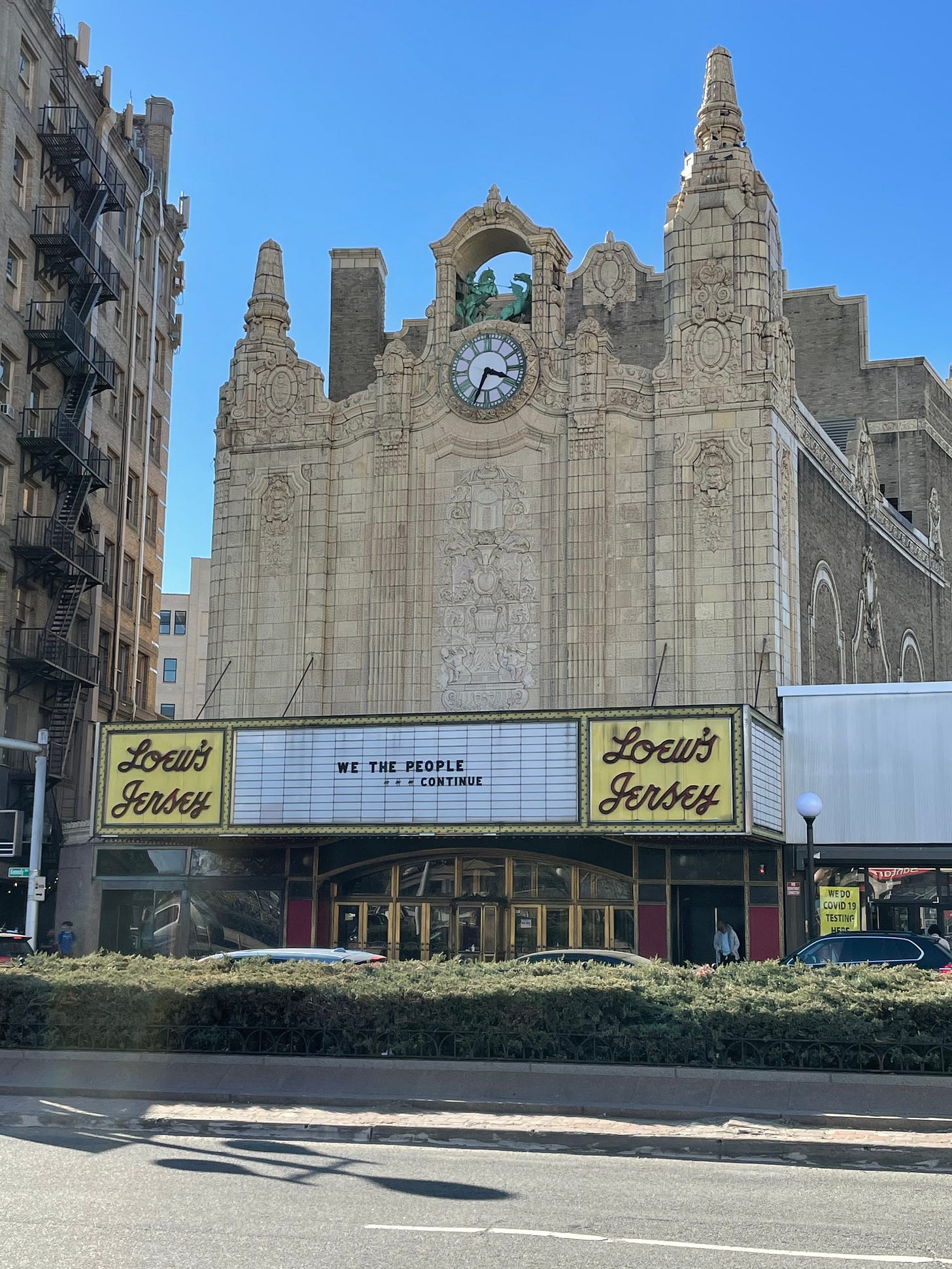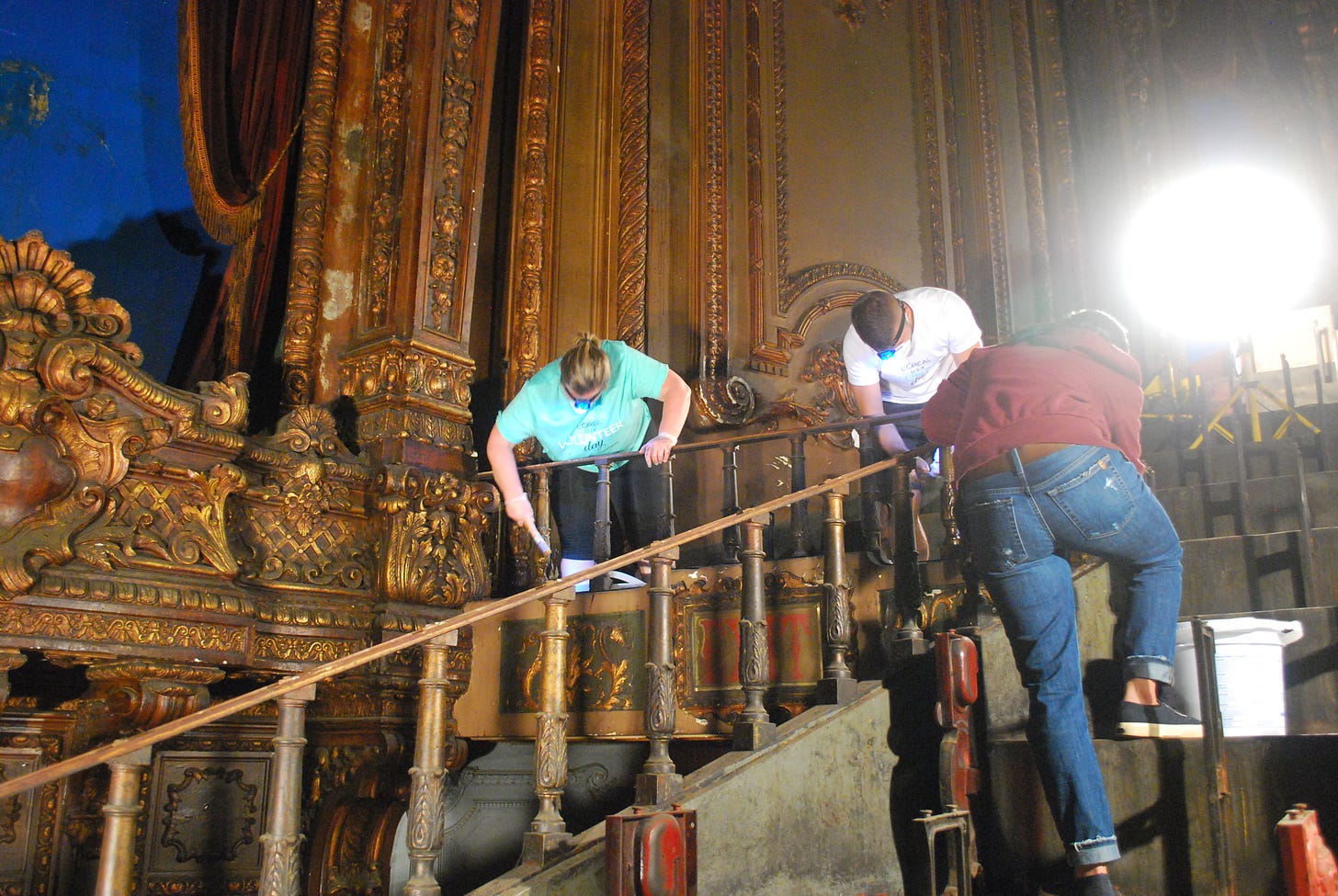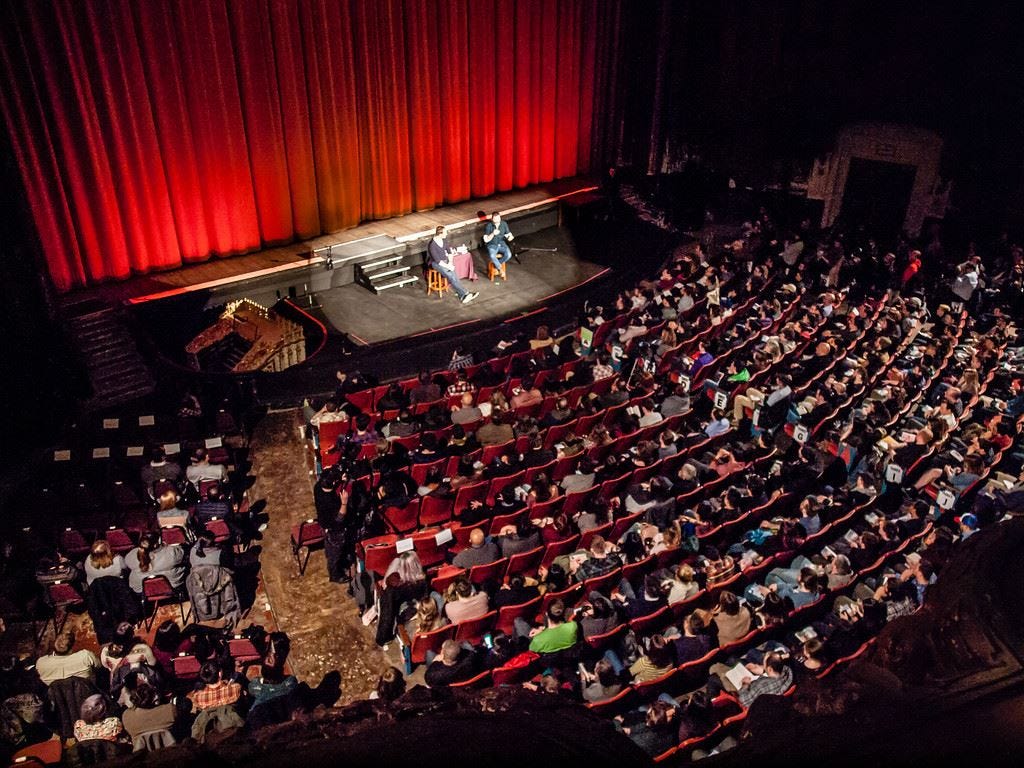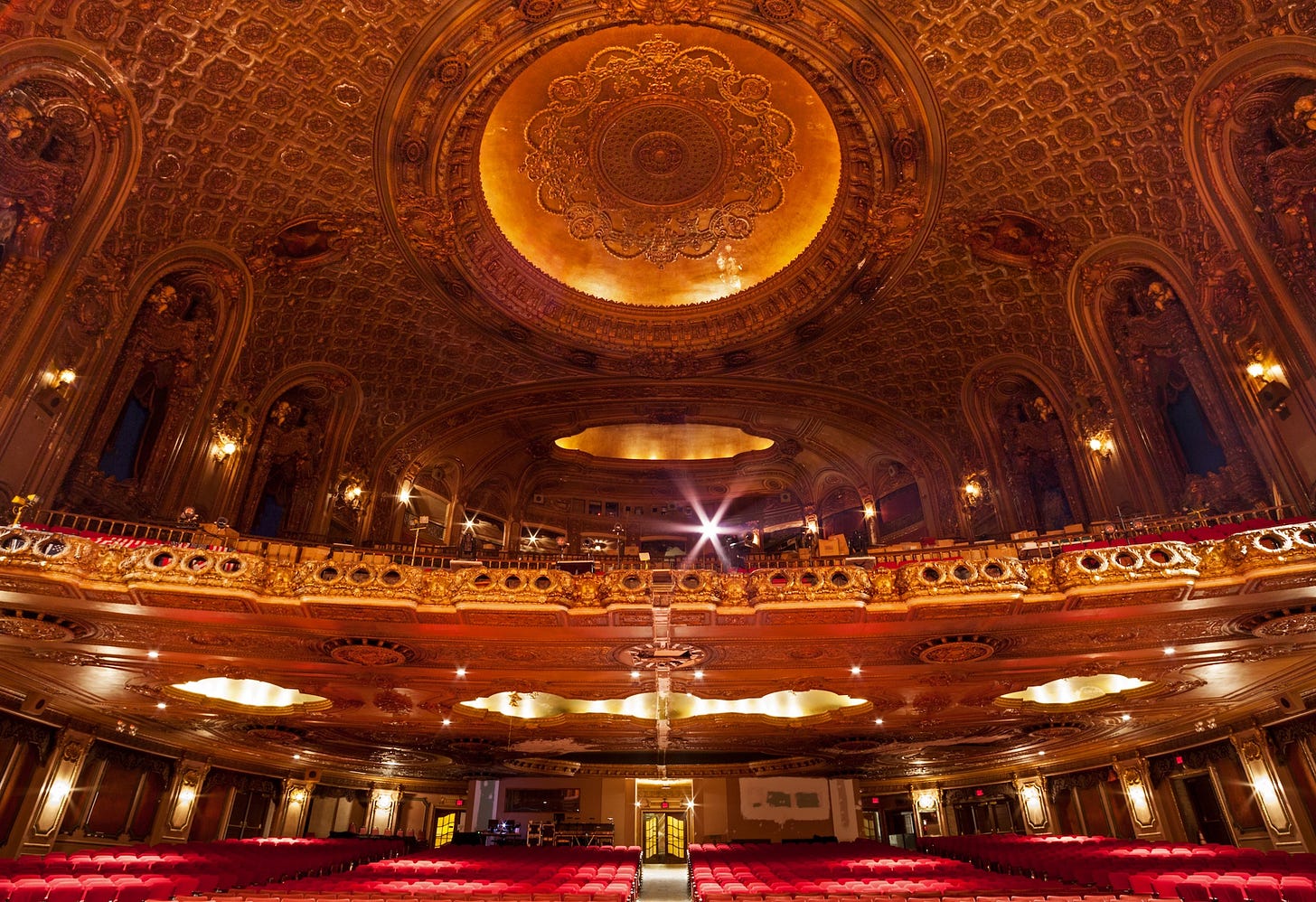"The Loew's became more than a restoration project - it became a statement about community values and who gets to determine a city's future."
I remember my first time walking into the Loew's Theatre at Journal Square. Though I'd lived downtown for years, I'd only admired its fascinating architecture from the outside whenever I emerged from the PATH station. Unlike any theater I'd seen in Europe, its marquee and façade always made me curious about how it looked inside.
Our friends Lori and Hans, who celebrated their wedding there, had told us how magnificent the interior was. But nothing prepared me for that moment in 2019 when I attended the Arches Fundraiser and finally stepped inside. When Colin Egan mentioned in our recent podcast conversation how much he enjoys watching people enter the theatre for the first time, I knew exactly what he meant - because I was one of those gasping people. I felt like a kid in a candy store: Lincrusta wallpaper, intricate plasterwork, velvet paneling... a treasure trove of architectural delights.
I'd heard about the volunteer effort behind the theater's restoration, but I'm embarrassed to admit it took me six years in Jersey City to learn the full story. And while I'd had an inkling of what a massive undertaking it must have been, it only truly hit me - another six years later - during my conversation with Colin for the podcast. The photos he shared left me breathless.
The Impossible Task
The sheer scale of what those volunteers faced was staggering. No water. No electricity. Widespread skepticism that they were embarking on an insane mission. It's a hero's journey straight out of mythology: the impossible dream, the seemingly insurmountable task, the naysayers making everything harder.
Yet there they were - a growing army of volunteers willing to solve problems on the fly. Like figuring out how to assemble scaffolding without proper training. Tackling bone-breaking work like dismantling the triplex walls that had divided the grand space. Painstakingly painting thousands of armrests and cleaning the plaster and velvet paneling. And discarding... so much discarding! Miles of moldy carpet, debris from dismantled walls, moldy seat cushions, and - in the projection booth alone - several feet of pigeon guano.
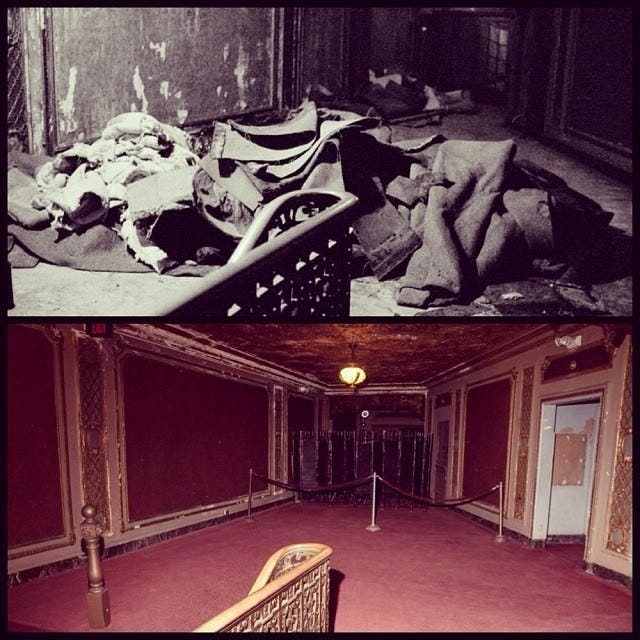
All this while dealing with emergencies like water pouring through the roof, which sent volunteers scrambling to chop ice and patch leaks in the dead of winter.
Small Victories, Big Impact
The journey was punctuated by small victories that kept spirits alive. Neighborhood stores like CH Martin evolving from skeptics to supporters. People with specialized technical skills appearing exactly when needed - like the Academy Award-winning sound technician who rebuilt the projection booth, or the phone company expert who helped restore the building's systems - expertise that would have been completely unaffordable otherwise.
Some stories within the larger narrative are especially moving. Like the years-long effort to recover, transport, and reassemble one of the original Wonder Theater organs, piece by intricate piece. Colin described the moment when, after years of meticulous work, the organ's sound finally resonated through the building. He stopped in his tracks, feeling as though he'd stepped through a time warp. A sound lost to history had returned.
The Theater as Community Anchor
What struck me most in my conversation with Colin was how the Loew's restoration became about so much more than saving a building. It evolved into a powerful force for community building in Jersey City.
Theaters like the Loew's were designed as democratic spaces - what Colin described as "palaces for everybody." Unlike other grand architecture that often separated people by class, movie palaces were explicitly built to bring everyone together under one ornate roof. This inclusivity was "built into its DNA, into the bricks of the building," as Colin put it.
The restoration effort honored this original purpose. When hundreds of volunteers from different backgrounds converged on the theater - chipping ice from the roof, removing debris, reassembling the organ - they weren't just preserving architecture; they were reviving a space where community happens. People who might never have met otherwise formed bonds through shared purpose and collective effort.
This reminds me of what Kelly Carroll shared about Brooklyn neighborhoods using preservation as a form of self-determination. Or how Jin Jung described her public art installations as ways for both herself and viewers to connect more deeply with Jersey City, especially as newcomers. Preservation creates belonging.
The Loew's story also demonstrates how cultural spaces anchor neighborhoods. When the Friends of the Loew’s organized those early events in the theater, people began to reimagine what the building - heck - Journal Square could be. Even before full restoration, bringing life back to the building brought life back to the square. As Tris McCall noted in his interview, these old structures can tell us something about "who we are and how we live" if we pay attention.
Perhaps most powerful was how the project allowed everyday residents to reclaim ownership of their city's narrative. When developers and officials dismissed the theater as not worth saving, volunteers proved through sweat equity that Jersey City deserved beautiful, accessible cultural spaces. They refused to accept the narrative that "this can't happen here," as Colin heard repeatedly in the early days.
In this way, the Loew's became more than a restoration project - it became a statement about community values and who gets to determine a city's future.
Key Lessons for Preservation (and Life)
What can we learn from this volunteer effort, not just for preservation projects but for any community endeavor?
1. Show People What's Possible
Colin repeatedly emphasized the importance of helping people envision what could be by physically bringing them into the space. Very early on the Friends of the Loew’s hosted events in the theater so residents could experience its grandeur and recognize what was at stake. This reminded me of Kelly Carroll's interview where she mentioned that bringing hundreds of people to the Waldorf-Astoria changed the new owners' perspective on how important the interiors were to many people.
2. Celebrate Small Victories
The Loew's restoration wasn't accomplished in one heroic push but through thousands of small victories over decades. Like when they first took down those dividing walls and could see the original grandeur of the space returning weekend by weekend. Or when the organ played its first notes after years of reassembly. These milestone moments kept volunteers motivated through the inevitable setbacks.
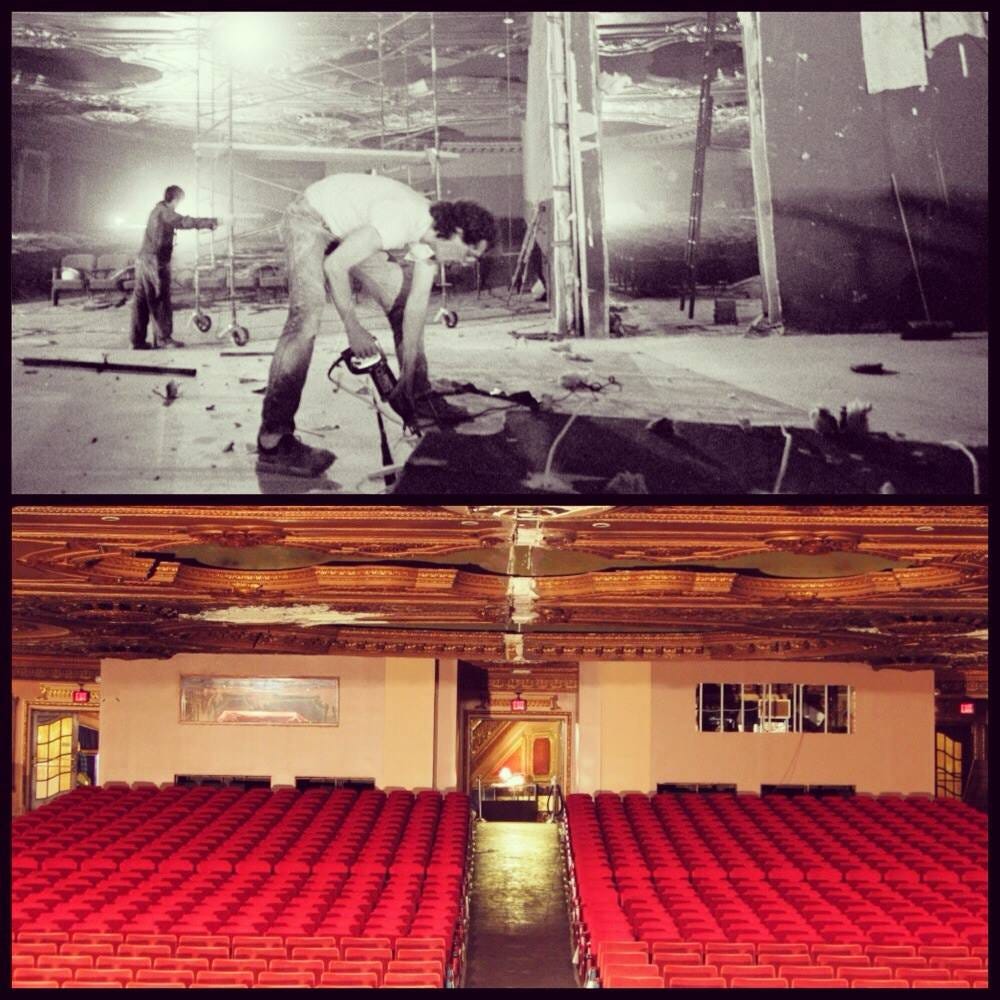
3. Connect the Work to the Mission
Colin noted how important it was to explain the significance of each task to volunteers, not just the big picture but how their specific project contributed to the theater's rebirth. People need to understand why they're scraping paint or chopping ice - how their individual efforts connect to the larger vision.
4. Build Community Through Shared Purpose
The Loew's effort shows that preservation isn't just about buildings but about creating community. Some of the strongest bonds form when people work together toward something meaningful. Like Jin Jung mentioned in her interview about creating ceramic markers for forgotten histories, making these connections helps us feel more rooted in places that weren't originally ours.
5. Use Old-School Organizing When Necessary
Before social media, Colin's team built support through neighborhood association meetings, printed flyers, and face-to-face conversations. They showed up at community events where "virtually everyone went." Sometimes these direct human connections create deeper commitment than clicking "like" or sharing a post.
6. Understand What You're Really Preserving
"If it doesn't remain that, we haven't really saved the Loew's," Colin said about maintaining the democratic spirit of the theater. "We've saved a building, a beautiful building, but we haven't saved the totality of it, the spirit of it all." This echoes what Tris McCall described about preservation being about more than architecture - it's about creating places where people from all backgrounds can gather and connect.
I hope the Friends of the Loew's will indeed remain stewards of both the building's history and its spirit. While the commercial operator may have plans that will generate millions, they're only able to do so because of this group of ordinary Jersey City residents who refused to give up.
For those of us who weren't part of that original rescue effort, we should remember their persistence - not just for the Loew's but as inspiration for saving the Powerhouse and other threatened landmarks. As preservationist Ted Conrad advised Colin early on (and now I'm adopting as my mantra): "Don't let them wear you down."
Sometimes that's all it takes to make the impossible possible.
This post accompanies my conversation with Colin Egan on Nat's Sidewalk Stories podcast. Listen to our full conversation here.





